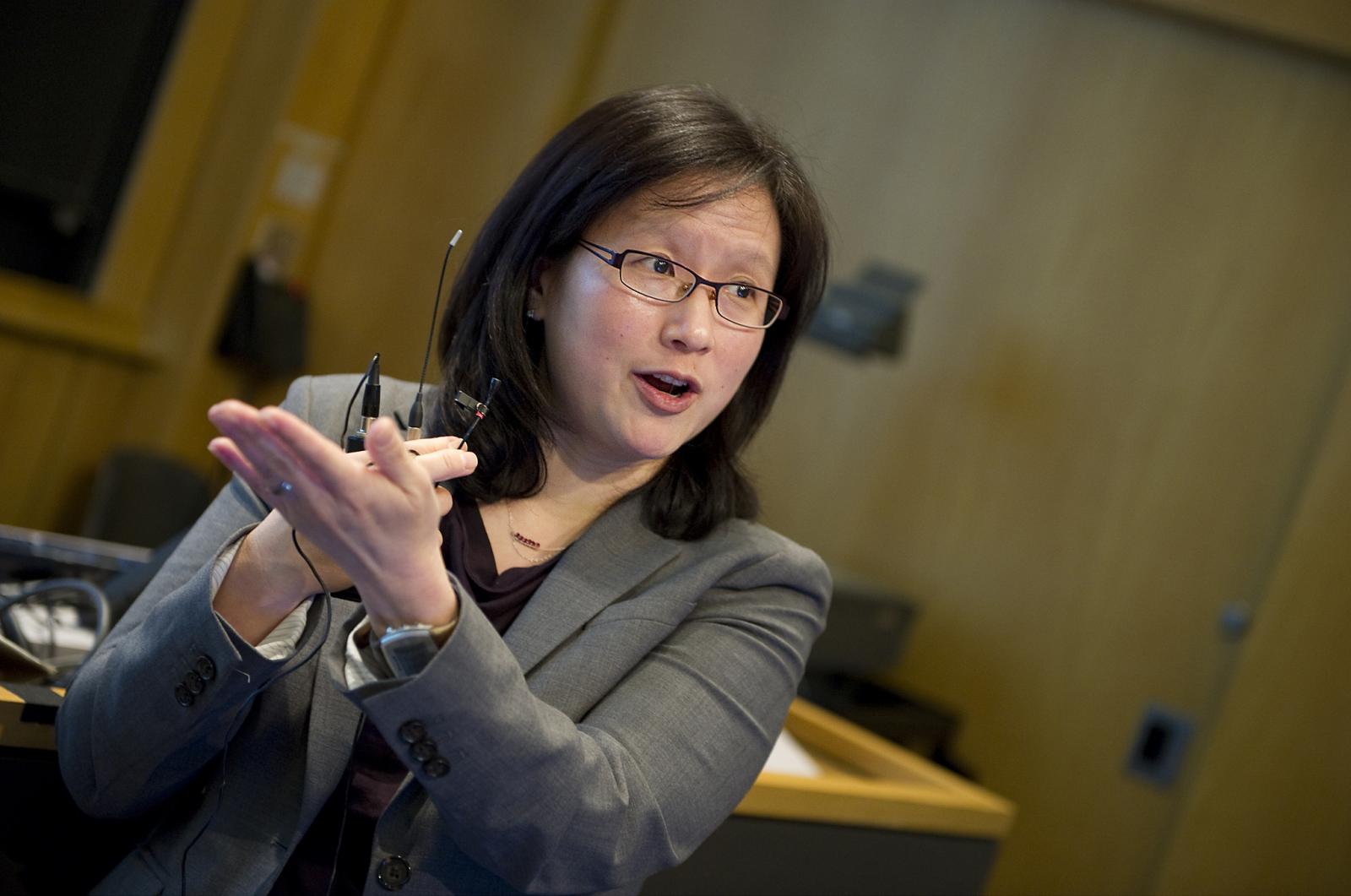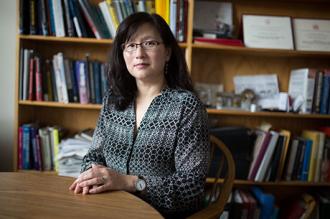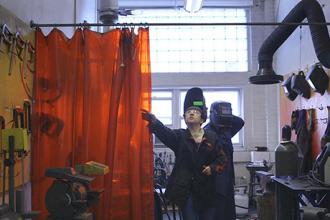close menu





Professor
Maria Yang
- Interim Dean of Engineering
- William E. Leonhard (1940) Professor
- Professor of Mechanical Engineering
- Associate Director, Morningside Academy of Design
Interests
- Early stage design process for products and systems
- Design representation, including visual, physical and linguistic
- System-level design for complex engineering systems
Professor Yang News + Media

Visual Thinking for Engineers
Professor Maria Yang has discovered valuable strategies and techniques for designing both consumer products and complex engineering systems, partnering with NASA, Ferrari, and IBM.

An eye for design
Maria Yang believes the ways in which people formulate ideas can significantly influence those products’ success.

Design for the Developing World
In MIT D-Lab class 2.729, Design for Scale, MIT students work with clients in the developing world to manufacture products in a more cost-efficient and effective way – from ambulances in Tanzania to an irrigation pump in Nepal.
Faculty Details
Education
-
1991
MASSACHUSETTS INSTITUTE OF TECHNOLOGY (MIT)
B.Sc. -
1994
STANFORD UNIVERSITY
M.Sc. -
2000
STANFORD UNIVERSITY
Ph.D.
Honors + Awards
- 2017 MacVicar Faculty Fellow
- 2016 Bose Excellence in Teaching Award
- 2014 ASEE Fred Merryfield Design Award
- 2014 Ruth and Joel Spira Excellence in Teaching Award
- 2014 Capers and Marion McDonald Mentoring Award
- 2013 ASME Fellow
- 2013 ASME Design Theory and Methodology Best Paper Award
- 2012 Earll Murman Award for Undergraduate Advising
- 2008 Robert N. Noyce Career Development Professorship
Memberships
- American Society of Mechanical Engineers (ASME)
- The Design Society
- Society of Automotive Engineers (SAE)
- American Society of Engineering Education (ASEE)
- American Institute of Aeronautics and Astronautics (AIAA)
- Tau Beta Pi Engineering Honor Society
- Pi Tau Sigma Mechanical Engineering Honor Society
Teaching
2.00B Toy Product Design (freshmen)
2.00 Introduction to Design (sophomores)
2.009 Product Engineering Processes (seniors)
2.739/15.783 Product Design and Development (graduate, joint with the Sloan School of Business and Rhode Island School of Design)
Publications
-
Bao, Q., Faas, D. and Yang, M. C., “Interplay Of Sketching & Prototyping In Early Stage Product Design,” International Journal of Design Creativity and Innovation, 1-23, 2018.
-
Bao, Q., Honda, T., El Ferik, S., Shaukat, M., and Yang, M. C., "Understanding the Role of Visual Appeal in Consumer Preference for Residential Solar Panels," Renewable Energy, 113, 1569-1579, 2017.
-
Murugappan, S., Piya, C., Yang, M. C., and Ramani, K., “FEASY: A Sketch-based Tool for Finite Element Analysis,” ASME Journal of Computing and Information Science in Engineering, 17(3), 031009, 2017.
- Fu, K., Yang, M. C., and Wood, K. L., “Design Principles: Literature Review, Analysis, and Future Directions,” ASME Journal of Mechanical Design, 138(10), 2016.
- Yu, B. Y., Honda, T., Zubair, S., Sharqawy, M. H., and Yang, M. C. "A maintenance focused approach to complex system design" Artificial Intelligence for Engineering Design, Analysis and Manufacturing, 30(3), 263-276, 2016.
- Agogino, A., Beckman, S., Castaños, C., Kramer, J., Roschuni, C., and Yang, M. Design Practitioners' Perspectives on Methods for Ideation and Prototyping. International Journal of Engineering Education, 32 (3), 2016.
- Austin-Breneman, J., Yu, B. Y., and Yang, M. C., "Biased Information Passing Between Subsystems Over Time in Complex System Design," ASME Journal of Mechanical Design, 138(1): 011101, 2015.
- Moreno, D., Blessing, L., Yang, M., Hernandez, A., Wood, K. L., “Overcoming Design Fixation: Design-by-Analogy Studies and Non-Intuitive Findings,” AI EDAM: Artificial Intelligence for Engineering Design, Analysis and Manufacturing, 30, 185-199, 2016.
- Klein, J., Stern, M., Franchin, G., Kayser, M., Inamura, C., Dave, S., Weaver, J. C., Houk, P., Colombo, P., Yang, M., and Oxman, N. "Additive Manufacturing of Optically Transparent Glass," 3D Printing and Additive Manufacturing, 2(3), 92-105, 2015.
- Häggman, A., Tsai, G., Elsen, C., Honda, T., and Yang, M. C., "Connections Between the Design Tool, Design Attributes, and User Preferences in Early Stage Design." ASME Journal of Mechanical Design, 137(7), 071408, 2015.
- Honda, T., Ciucci, F., Lewis, K., and Yang, M. C. “A comparison of information passing strategies in system level modeling.” AIAA Journal, 53 (5), 1121-1133.
- Fu, K., Murphy, J., Yang, M., Otto, K., Jensen, D., and Wood, K., 2015, "Design-by-analogy: experimental evaluation of a functional analogy search methodology for concept generation improvement”, Research in Engineering Design, 26 (1), 77-95.
- Fu, K., Moreno, D., Yang, M., and Wood, K. L., (2014) “Bio-Inspired Design: An Overview Investigating Open Questions From the Broader Field of Design-by-Analogy,” ASME Journal of Mechanical Design, 136(11): 111102.
- Murphy, J., Fu, K., Otto, K., Yang, M. C., Jensen, D., and Wood, K. (2014) “Function Based Design-by-Analogy: A Functional Vector Approach to Analogical Search,” ASME Journal of Mechanical Design, 136 (10):101102.
- Moreno, D. P., Hernandez, A., Yang, M. C., Otto, K. N., Holtta-Otto, K., Linsey, J. S., Wood, K. L., and Linden, A. (2014) “Fundamental Studies in Design-By-Analogy: A Focus on Domain-Knowledge Experts and Applications to Transactional Design Problems,” Design Studies, 35(3):232-272.
- Schlecht, L. and Yang, M. C. (2014) “Impact of Prototyping Resource Environments on Idea Generation in Product Design,” Technovation, 34(4):223-231.
- Dong, A., Sarkar, S., Yang, M.C., and Honda, T. (2014) "A linguistic approach to assess the dynamics of design team preference in concept selection," Research in Engineering Design, 25(1):75-92.
- D. Faas, Q. Bao, D. Frey, and M. C. Yang (to appear May 2014) "The Influence of Immersion and Presence in Early Stage Engineering Designing and Building," AI EDAM: Artificial Intelligence for Engineering Design, Analysis and Manufacturing, 28(2).
- H. Chen, T. Honda, and M. C. Yang, (2013) "Approaches for Identifying Consumer Preferences for the Design of Technology Products: A Case Study of Residential Solar Panels," ASME Journal of Mechanical Engineering Design, 135(6), 061007.
- J. Austin-Breneman, T. Honda, M. C. Yang (2012) "A Study of Student Design Team Behaviors in Complex System Design." ASME Journal of Mechanical Design. 134, 124504.C. Elsen, J. Demaret, M. C. Yang, and P. Leclercq (2012). "Sketch‐Based Interfaces for Modeling and Users' Needs: Redefining Connections." AI EDAM: Artificial Intelligence for Engineering Design, Analysis and Manufacturing. 24(3):303-316.
- H. Ji, M. C. Yang, and T. Honda (2012) “An approach to the extraction of probabilistic preference-related information from design team language.” Research in Engineering Design. 23(2):85-103
- T. Honda, F. Ciucci, and M. C. Yang. (2012) “An Information Passing Strategy for Achieving Pareto Optimality in the Design of Complex Systems.” Research in Engineering Design. 23(1):71–83
- C. J. Walthall, S. Devanathan, K. Ramani, E. D. Hirleman, L. G. Kisselburgh, and M. C. Yang. (2011) “Evaluating Wikis as a Communicative Medium for Collaboration within Co-located and Distributed Engineering Design Teams.” ASME Journal of Mechanical Design. 133(7):071001.
- M. C. Yang (2010). "Consensus and Single Leader Decision-making in Teams Using Structured Design Methods." Design Studies. 31(4):345-362.
- J. Lai, T. Honda, and M. C. Yang. (2010) “A Study of the Role of User-Centered Design Methods in Design Team Projects.” AI EDAM: Artificial Intelligence for Engineering Design, Analysis and Manufacturing. 24(3):303-316.
- M. C. Yang.(2009) “Observations on Concept Quantity and Sketching in Design.” Research in Engineering Design. 20(1):1-11 .
- Z. Li , M. C. Yang, and K. Ramani (2009). "A Methodology for Engineering Ontology Acquisition and Validation.” AI EDAM: Artificial Intelligence for Engineering Design, Analysis and Manufacturing. 23(1): 37-51.
- M. C. Yang and Y. Jin. (2008) “An Examination of Team Effectiveness in Distributed and Co-located Engineering Teams.” International Journal of Engineering Education. 24(2): 400-408.
- M. C. Yang and J. G. Cham (2007) “An Analysis of Sketching Skill and its Role in Early Stage Engineering Design.” ASME Journal of Mechanical Design. 129(5): 476-482.
- M. C. Yang. (2005) "A study of prototypes, design activity, and design outcome." Design Studies. 26 (6): 649-669.
- M. C. Yang, W. Wood and M. Cutkosky. (2005) "Design information retrieval: a thesauri-based approach for reuse of informal design information." Engineering with Computers. 21 (2): 177-192.
- J. T. Dennerlein and M. C. Yang. (2001) "Haptic Force-Feedback Devices for the Office Computer: Performance and Musculoskeletal Loading Issues." Human Factors. 43 (2): 278-86.
- D. Crow and M. C. Yang. (2001) “Industry Briefs: Reactivity.” ACM Interactions. 8(2): 71 – 74.
General Research
- Early stage design process
- Experimental studies of designers and design process
- Design methods